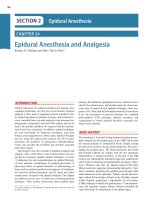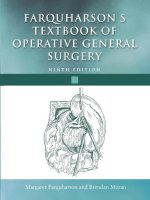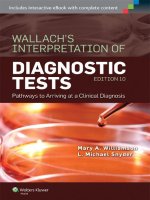Ebook King’s applied anatomy of the central nervous system of domestic mammals (2/E): Part 1
Bạn đang xem bản rút gọn của tài liệu. Xem và tải ngay bản đầy đủ của tài liệu tại đây (20.24 MB, 267 trang )
TableofContents
Cover
TitlePage
ForewordtotheSecondEdition
Preface
Acknowledgement
AbouttheContributors
AbouttheCompanionWebsite
1ArterialSupplytotheCentralNervousSystem
ArterialSupplytotheBrain
1.1BasicPatternoftheMainArteriesSupplyingtheBrain
1.2BasicPatternofIncomingBranchestotheCerebralArterialCircle
1.3SpeciesVariations
1.4SummaryoftheSignificanceoftheVertebralArteryasaSourceof
BloodtotheBrain
1.5HumaneSlaughter
1.6ReteMirabile
SuperficialArteriesoftheSpinalCord
1.7MainTrunks
1.8AnastomosingArteries
1.9SegmentalArteriestotheSpinalCord
1.10GeneralPrinciplesGoverningtheDistributionofArteriesbelowthe
SurfaceoftheNeuraxis
1.11TheDeepArteriesoftheSpinalCord
1.12TheProblemofPulsation
1.13ArterialAnastomosesoftheNeuraxis
2TheMeningesandCerebrospinalFluid
Meninges
2.1GeneralAnatomyoftheCranialandSpinalMeninges
2.2AnatomyoftheMeningesattheRootsofSpinalandCranialNerves
2.3TheSpacesaroundtheMeninges
2.4RelationshipofBloodVesselstotheMeninges
2.5TheFilumTerminale
2.6TheFalxCerebriandMembranousTentoriumCerebelli
CerebrospinalFluid
2.7FormationofCerebrospinalFluid
2.8TheChoroidPlexuses
2.9MechanismofFormationofCerebrospinalFluid
2.10CirculationofCerebrospinalFluid
2.11DrainageofCerebrospinalFluid
2.12FunctionsofCerebrospinalFluid
2.13Blood‐brainBarrier
2.14CollectionofCerebrospinalFluid
2.15ClinicalConditionsoftheCerebrospinalFluidSystem
3VenousDrainageoftheSpinalCordandBrain
TheCranialSystemofVenousSinuses
3.1GeneralPlan
3.2TheComponentsoftheDorsalSystemofSinuses
3.3TheComponentsoftheVentralSystemofSinuses
3.4DrainageoftheCranialSinusesintotheSystemicCirculation
TheSpinalSystemofVenousSinuses
3.5GeneralPlan
3.6ConnectionstotheCranialSystemofSinuses
3.7TerritoryDrainedbytheSpinalSystemofSinuses
3.8DrainageoftheSpinalSinusesintotheSystemicCirculation
ClinicalSignificanceoftheVenousDrainageoftheNeuraxis
3.9SpreadofInfectionintheHead
3.10ParadoxicalEmbolism
3.11VenousObstruction
3.12AngiographyforDiagnosis
4TheAppliedAnatomyoftheVertebralCanal
TheAnatomyofEpiduralAnaesthesiaandLumbarPuncture
4.1TheVertebrae
4.2SpinalCord
4.3Meninges
4.4LumbarPuncture
4.5EpiduralAnaesthesiaintheOx
4.6InjuriestotheRootoftheTail
TheAnatomyoftheIntervertebralDisc
4.7TheComponentsoftheDisc
4.8SenileChanges
4.9DiscProtrusion
4.10FibrocartilaginousEmbolism
MalformationorMalarticulationofVertebrae
4.11The‘WobblerSyndrome’intheDog
4.12TheWobblerSyndromeintheHorse
4.13Atlanto‐AxialSubluxationinDogs
4.14AnomalousAtlanto‐OccipitalRegioninArabHorses
4.15OtherVertebralAbnormalitiesinDogs
5TheNeuron
TheAnatomyofNeurons
5.1GeneralStructure
5.2TheAxon
5.3Epineurium,PerineuriumandEndoneurium
5.4TheSynapse
5.5PhylogeneticallyPrimitiveandAdvancedNeurons
5.6AxonalDegenerationandRegenerationinPeripheralNerves
5.7RegenerationandPlasticityintheNeuraxis
5.8StemCellsandOlfactoryEnsheathingCells
5.9TheReflexArc
5.10Decussation:TheCoilingReflex
6TheNerveImpulse
ExcitationandInhibition
6.1IonChannelsandGatingMechanisms
6.2TheMembranePotential
6.3TheExcitatoryPostsynapticPotential
6.4TheInhibitoryPostsynapticPotential
6.5TheReceptorPotential
6.6TheEnd‐platePotential
6.7SummaryofDecrementalPotentials
6.8TheActionPotential
6.9ConcerningWaterClosets
6.10TransducerMechanismsofReceptors
6.11Astrocytes
6.12Oligodendrocytes
6.13Microglia
7NucleioftheCranialNerves
GeneralPrinciplesGoverningtheArchitectureoftheNucleiofthe
CranialNerves
7.1ShapeandPositionoftheCentralCanal
7.2FragmentationoftheBasicColumnsofGreyMatter
7.3DevelopmentofanAdditionalComponent;SpecialVisceralEfferent
7.4TheCranialNervesoftheSpecialSenses
7.5SummaryoftheArchitecturalPrinciplesoftheNucleioftheCranial
Nerves
Names,TopographyandFunctionsoftheCranialNerveNuclei
7.6SomaticAfferentNucleus
7.7VisceralAfferentNucleus
7.8VisceralEfferentNuclei
7.9SpecialVisceralEfferentNuclei
7.10SomaticEfferentNuclei
ReflexArcsoftheNucleioftheCranialNerves
SignificanceoftheNucleioftheCranialNervesinClinicalNeurology
8MedialLemniscalSystem
ConsciousSensoryModalities,theirReceptorsandPathways
8.1ConsciousSensoryModalities
8.2PeripheralReceptorsofTouch,PressureandJointProprioception
8.3PathwaysofTouch,PressureandJointProprioception
ClinicalConditionsAffectingtheMedialLemniscalSystem
8.4EffectsofLesionsintheDorsalFuniculus
PainPathways
8.5PeripheralReceptorsofPain
8.6SpinothalamicTractofMan
8.7SpinothalamicPathwaysinDomesticMammals
8.8SpinocervicalTract(SpinocervicothalamicTract)
8.9SpeciesVariationsintheMedialLemniscalSystem
8.10SomatotopicLocalisation
8.11BlendingofTractsintheSpinalCord
8.12SummaryoftheMedialLemniscusSystem
9TheSpecialSenses
Vision
9.1Neuron1
9.2Neuron2
9.3Neuron3
Hearing
9.4Neuron1
9.5Neuron2
9.6Neuron3
Balance
9.7Neuron1
9.8Neuron2
Taste
9.9Neuron1
9.10Neuron2
9.11Neuron3
OlfactionProper:TheSenseofSmell
9.12Neuron1
9.13Neuron2
9.14Neuron3
SummaryoftheConsciousSensorySystems
10SpinocerebellarPathwaysandAscendingReticularFormation
10.1SpinocerebellarPathways
10.2AscendingReticularFormation
SpinocerebellarPathways
10.3Hindlimbs
10.4Forelimbs
10.5ProjectionsofSpinocerebellarPathwaystotheCerebralCortex
10.6FunctionsoftheSpinocerebellarPathways
10.7SpeciesVariations
AscendingReticularFormation
10.8Organisation
FunctionsoftheAscendingReticularFormation
10.9Arousal
10.10TransmissionofDeepPain
10.11SummaryofSpinocerebellarPathwaysandAscendingReticular
Formation
11SomaticMotorSystems
SomaticEfferentNeurons
11.1MotorNeuronsintheVentralHornoftheSpinalCord
MuscleSpindles
11.2StructureoftheMuscleSpindle
11.3TheModeofOperationoftheMuscleSpindle
11.4RoleofMuscleSpindlesinPostureandMovement
11.5GolgiTendonOrgans
11.6MuscleTone
11.7MotorUnit
11.8RecruitmentofMotorUnits
11.9SummaryofWaysofIncreasingtheForceofContractionofa
Muscle
TheFinalCommonPath
11.10AlgebraicSummationattheFinalCommonPath
11.11RenshawCells
11.12LowerMotorNeuron
11.13IntegrationoftheTwoSidesoftheNeuraxis
12PyramidalSystem
PyramidalPathways
12.1TheNeuronRelay
FeedbackPathwaysofthePyramidalSystem
12.2FeedbackofthePyramidalSystem
ComparativeAnatomyofthePyramidalSystem
12.3SpeciesVariationsinthePrimaryMotorAreaoftheCerebralCortex
12.4SpeciesVariationsinthePyramidalSystem
12.5TheFunctionofthePyramidalSystem
ClinicalConsiderations
12.6EffectsofLesionsinthePyramidalSystem
12.7ValidityoftheDistinctionbetweenPyramidalandExtrapyramidal
Systems
13ExtrapyramidalSystem
MotorCentres
13.1NineCommandCentres
13.2TheCerebralCortex
13.3BasalNucleiandCorpusStriatum
13.4MidbrainReticularFormation
13.5RedNucleus
13.6MesencephalicTectum
13.7PontineMotorReticularCentres
13.8LateralMedullaryMotorReticularCentres
13.9MedialMedullaryMotorReticularCentres
13.10VestibularNuclei
SpinalPathways
13.11PontineandMedullaryReticulospinalTracts
13.12RubrospinalTract
13.13VestibulospinalTract
13.14TectospinalTract
13.15ThePositionintheSpinalCordoftheTractsoftheExtrapyramidal
System
13.16SummaryoftheTractsoftheExtrapyramidalSystem
14ExtrapyramidalFeedbackandUpperMotorNeuronDisorders
FeedbackoftheExtrapyramidalSystem
14.1NeuronalCentresoftheFeedbackCircuits
14.2FeedbackCircuits
14.3BalancebetweenInhibitoryandFacilitatoryCentres
14.4ClinicalSignsofLesionsinExtrapyramidalMotorCentresinMan
14.5ClinicalSignsofLesionsintheBasalNucleiinDomesticAnimals
14.6UpperMotorNeuronDisorders
15SummaryoftheSomaticMotorSystems
TheMotorComponentsoftheNeuraxis
15.1PyramidalSystem
15.2ExtrapyramidalSystem
15.3DistinctionbetweenPyramidalandExtrapyramidalSystems
ClinicalSignsofMotorSystemInjuries
15.4FunctionsofthePyramidalandExtrapyramidalSystems:Effectsof
InjurytotheMotorCommandCentres
15.5UpperMotorNeuron
15.6LowerMotorNeuron
15.7SummaryofProjectionsontotheFinalCommonPath
16TheCerebellum
AfferentPathwaystotheCerebellum
16.1AscendingfromtheSpinalCord
16.2FeedbackInputintotheCerebellarCortex
SummaryofPathwaysintheCerebellarPeduncles
16.3CaudalCerebellarPeduncle
16.4MiddleCerebellarPeduncle
16.5RostralCerebellarPeduncle
RostralCerebellarPeduncle
16.6VestibularAreas
16.7ProprioceptiveAreas
16.8FeedbackAreas
FunctionsoftheCerebellum
16.9Co‐ordinationandRegulationofMovement
16.10ControlofPosture
16.11IpsilateralFunctionoftheCerebellum
16.12SummaryofCerebellarFunction
16.13FunctionalHistologyoftheCerebellum
ClinicalConditionsoftheCerebellum
16.14TheThreeCerebellarSyndromes
16.15CerebellarDiseaseinDomesticMammalsandMan
17AutonomicComponentsoftheCentralNervousSystem
NeocortexandHippocampus
17.1CorticalComponents
17.2Hippocampus
Diencephalon
17.3Hypothalamus
TheAutonomicFunctionsoftheHypothalamus
17.4AmygdaloidBodyandSeptalNuclei
17.5HabenularNuclei
17.6HindbrainAutonomicAreas
TheAutonomicAreasoftheHindbrain
17.7AutonomicMotorPathwaysintheSpinalCord
17.8Ascending(Afferent)VisceralPathwaysintheSpinalCordand
Brainstem
ClinicalDisordersoftheAutonomicSystem
17.9EffectsofLesionsinAutonomicPathways
17.10SummaryofDescendingAutonomicPathways
18TheCerebralCortexandThalamus
CerebralCortex
18.1ProjectionAreasandAssociationAreas
18.2Instinct
18.3CerebralCortexinPrimitiveMammals
18.4CerebralCortexintheCatandDog
18.5ConditionedReflexes
18.6CerebralCortexinMan
18.7CognitiveAssociationAreainMan
18.8CognitiveAssociationAreainCarnivores
18.9InterpretativeAssociationAreainMan
18.10InterpretativeAssociationAreainCarnivores
18.11FrontalAssociationAreainMan
18.12FrontalAssociationAreainCarnivores
18.13CorpusCallosum
ClinicalConditionsoftheCerebralCortex
18.14EffectsofExtensiveDamagetotheCerebralHemispherein
DomesticMammals
18.15Seizures
HistologyoftheCerebralCortex
18.16HistologyoftheCerebralCortex
Thalamus
18.17VentralGroupofThalamicNuclei
18.18TheLateralGroup
18.19Central(orIntralaminar)Group
18.20DorsomedialGroup
18.21SummaryofIncomingAfferentPathstotheThalamus
18.22SummaryoftheProjectionsfromtheThalamustotheCerebral
Cortex
18.23SummaryofFunctionsoftheThalamus
18.24ClinicalEffectsofLesionsoftheThalamusinDomesticMammals
18.25ClinicalEffectsofLesionsoftheThalamusinMan
GrowthoftheHumanBrain
19EmbryologicalandComparativeNeuroanatomy
TheEmbryologicalDevelopmentoftheCentralNervousSystem
19.1TheDevelopmentoftheBrain
19.2TheDevelopmentoftheSpinalCord
19.3TheDevelopmentoftheNeuralCrest
EvolutionoftheVertebrateForebrain
19.4PrimitiveVertebrates
19.5ContemporaryAmphibian
19.6ContemporaryAdvancedReptile
19.7Mammal
19.8Bird
19.9MajorHomologiesinMammalsandBirds
EvolutionoftheCapacitytoDifferentiateSensoryModalities
19.10LowerVertebrates,IncludingAmphibians
19.11AdvancedReptilesandBirds
19.12Mammals
SpecialFeaturesoftheAvianBrain
19.13SizeoftheBrain
19.14PoorDevelopmentoftheCerebralCortex
19.15ExternalStriatum
19.16Colliculi:TheOpticLobe
19.17OlfactoryAreas
19.18Cerebellum
19.19SpinocerebellarPathways
19.20CuneateandGracileFascicles
19.21MotorSpinalPathways
20ClinicalNeurology
20.1MentalStatus
20.2Posture
20.3Gait
20.4ExaminationoftheCranialNerves:TestsandObservations
TestingPosturalandLocomotorResponses
20.5TonicNeckandEyeResponses
20.6ProprioceptivePositioningResponses
20.7PlacingResponses
20.8ExtensorPosturalThrust
20.9Hopping
20.10WheelbarrowTest
20.11Hemiwalking
20.12Righting
20.13Blindfolding
20.14CirclingTest
20.15SwayTest
ExaminationofSpinalReflexes
20.16Withdrawal(Flexor)Reflex
20.17PatellarTendonReflex
20.18TricepsTendonReflex
20.19BicepsTendonReflex
20.20CutaneousTrunci/Colli(FormerlyPanniculus)Reflex
20.21PerinealReflex
20.22CrossedExtensorReflex
20.23BabinskiReflex
OtherTests
20.24AssessmentofMuscleTone
20.25TestingConsciousPainResponses
20.26DetectingDiscomfort
20.27TestingtheSympatheticSystem
20.28CaseSheet
21ImagingTechniquesforStudyoftheCentralNervousSystem
GeneralConsiderations
21.1Species
21.2ObjectivesofImaginginClinicalNeurology
21.3ComputedTomographyandMagneticResonanceImaging
21.4TheUseofContrastAgentsinImaging
IntracranialStructures
21.5PositioningoftheHead
21.6BreedandAgeVariationinImagesoftheHead
VertebralColumn
21.7PositioningofthePatient
21.8ImagingtheVertebralColumn
21.9ContrastRadiographyoftheVertebralColumn
22TopographicalAnatomyoftheCentralNervousSystem
SpinalCord
22.1RegionsoftheSpinalCord
22.2SegmentsofSpinalCordandtheirRelationshiptoVertebrae
22.3GeneralOrganisationofGreyandWhiteMatter
22.4Dorsal,LateralandVentralHornsofGreyMatter
22.5LaminaeofGreyMatter
22.6FuniculiofWhiteMatter
22.7TractsoftheWhiteMatter
MedullaOblongata
22.8GrossStructure
22.9CranialNerves
22.10VentricularSystem
22.11InternalStructure
Pons
22.12GrossStructure
22.13CranialNerves
22.14VentricularSystem
22.15InternalStructure
Midbrain
22.16GrossStructure
22.17CranialNerves
22.18VentricularSystem
22.19InternalStructure
Diencephalon
22.20GrossStructure
22.21CranialNerves
22.22VentricularSystem
22.23InternalStructure
Cerebellum
22.24GrossStructure
22.25InternalStructure
22.26CerebellarPeduncles
CerebralHemispheres
22.27GrossStructure
22.28VentricularSystem
22.29InternalStructure
23Electrodiagnostics
23.1Introduction
23.2Electromyography
23.3NerveConductionVelocity
23.4Electroencephalography
23.5EvokedPotentials
23.6Electroretinography
23.7Intra‐operativeMonitoringofSpinalCordFunction
24DiagnosticExercises
24.1Introduction
24.2SolutionstoDiagnosticExercises
Appendix
FurtherReading
Index
EndUserLicenseAgreement
ListofTables
Chapter07
Table7.1Summaryofthenucleiofthecranialnerves.
Chapter21
Table21.1IntensityofdifferenttissuesinMRimagesobtainedwithT1
andT2weighting.
Appendix
TableA1Thefunctionsofthecranialnerves
TableA2Thespinalnervesandtheirmajorfunctions.Belowarelisted
themajorspinalnervestogetherwiththeirprincipalsensoryand/ormotor
functions.Minorbranchesarenotincluded.Theprincipaloriginofthe
nervesfromthespinalcordsegmentsisgiven,butthereisconsiderable
variation.Spinalcordsegmentinbracketsmeansinconsistent,minor
contribution.ThistableshouldbeconsultedalongwithTablesA3and
A4.Abbreviations:SNS = somaticnervoussystem;ANS = autonomic
nervoussystem;n = nerve;andnn = nerves.
TableA3Thefunctionofthemusclesoftheforelimb
TableA4Asummaryofthefunctionofthemusclesofthehindlimb
ListofIllustrations
Chapter01
Figure1.1Diagramofthecerebralarterialcircleanditsoutgoing
branches.Theconnectionacrossthemidlineattherostralendofthe
circleisinconstantinthedogandruminants.
Figure1.2Diagramshowingthepotentialarterialchannelstothe
cerebralarterialcircle.Therearefoursuchchannels,numbered1to4on
theleft:1 = theinternalcarotidartery;2 = thebasilarartery;3 = the
anastomosingramusfromthemaxillaryarterytotheinternalcarotid
artery;and4 = theconnectionofthevertebralarterytotheinternal
carotidartery.
Figure1.3Diagramsshowingspeciesvariationsinthesourcesofarterial
bloodtothebrain.Ineachfiguretheupperdiagramshowsthe
distributionoverthebrainofinternalcarotid,vertebralandmaxillary
bloodintheintactliveanimal(seekey);thelowerdiagramshowsthe
anatomywhichaccountsforthisdistribution,basedonthefourpotential
arterialchannelstothecerebralarterialcircle.Arrowsshowthedirection
offlowinthebasilarartery.Thevertebral–occipitalanastomosis(VO)
canbedisregardedintheintactanimal.1 = internalcarotidartery;2 =
basilarartery;3 = anastomosingramusfrommaxillaryarterytointernal
carotidartery;and4 = connectionofvertebralarterytointernalcarotid
artery.(a)Dog,manandmanyotherspecies.1(internalcarotidartery)
and2(basilarartery)supplythearterialcircle;thebasilararterycarries
bloodtothearterialcircle.Neitherchannelhasaretemirabile.Internal
carotidbloodreachesallofthecerebralhemisphereexceptitsmost
caudalpart.Vertebralbloodsuppliestheremainderofthecerebral
hemisphere,andalltherestofthebrain.(b)Sheepandcat.Only3
(maxillaryanastomosingramus)suppliesthearterialcircle.Ithasarete
mirabile.2(basilarartery)carriesbloodawayfromthearterialcircle.
Maxillarybloodisdistributedtoallofthebrainexceptthecaudalpartof
themedullaoblongata,whichissuppliedbyvertebralblood.(c)Ox.3
(anastomosingramus)and4(vertebralartery)bothsupplythearterial
circle.Eachhasaretemirabile.2(basilarartery)carriesbloodawayfrom
thearterialcircle.Amixtureofmaxillaryandvertebralbloodreachesall
partsofthebrain.
Figure1.4(a),(b)Diagramshowingtheprobableevolutionoftherete
mirabile.Thetrigeminalnerve(V)receivessmallnutrientbranchesfrom
theinternalcarotidartery1)andmaxillaryartery3),inmammals
generally(a).Whentheinternalcarotidisobliteratedinruminantsand
thecat,thesenutrientvesselsanastomoseacrossthetrigeminalnerveand
soformtheretemirabile(b).
Figure1.5Diagramofthesuperficialarteriesofthespinalcordina
hypotheticalmammal.Onlytheventralspinalarteryisconstantand
relativelylargeinmammalsgenerally.Thepaireddorsolateralarteries,
theanastomosingarterialnetworkconnectingthesetotheventralspinal
artery,andthearterialringatthelevelofeachintervertebralforamen,are
allinconstantandirregularindispositiondependingonthespecies.
Thesesuperficialarteriesaresuppliedbypairedsegmentalspinal
arteries,whichenterthevertebralcanalasthedorsalrootarteryand
ventralrootarteryoneachside.
Figure1.6Diagramshowingthedeeparteriesofthespinalcord.The
innerzoneissuppliedbyverticalarteriesonly.Themiddlezone
(uncoloured)issuppliedbybothverticalandradialarteries.Theouter
zoneissuppliedbytheradialarteriesonly.
Chapter02
Figure2.1Diagramoftheneuraxissuspendedinthemeninges.Theleft‐
handarrowindicatesatransversesectionthroughthebrainandits
meninges.Theright‐handarrowindicatesatransversesectionthrough
thespinalcord.Thefilumterminaletethersthecaudalendofthespinal
cordtothecoccygealvertebrae.
Figure2.2Diagramoftheintracranialmeningesandtheirbloodvessels.
Thebloodvesselsonthesurfaceofthebrainaresuspendedinthepia‐
arachnoid.TheformationofCSFfromasmallarteryandanarterioleis
indicatedbythesmallarrows.AbsorptionofCSFintoasmallveinis
indicatedbythelargearrows.
Figure2.3Highlydiagrammatictransversesectionofaventricleofthe
brainanditschoroidplexus.Itshowsthechoroidplexusinvaginatedinto
thelumenoftheventricle.Acapillaryloopiscontainedwithinthe
choroidplexus.Thepiamaterextendsaroundtheloopasabasallamina
(brokenline).Theependymalepitheliumismodifiedintocuboidal
glandularcellswhichhavetheirbasesrestingonthebasallamina.The
formationofCSFisindicatedbyarrows.
Figure2.4Dorsalviewdiagramoftheventriclesofthebrain.The
medianapertureofthefourthventricleoccursinmanbutnotinthe
domesticmammals.Theaperturesofthefourthventricleconnectthe
ventricletothesubarachnoidspace.
Figure2.5SagittalMRIscanofadog’sbrainandrostralcervicalspine.
Themedianapertureisseenasanopeningintothecentralcanalfromthe
fourthventricleisvisible.Asyrinx(syringomyelia)canalsobeseen.
ThereisdistortionoftheimagecausedbyamicrochipdorsaltoC5.
Figure2.6Diagrammatictransversesectionthroughthefalxcerebri.The
dorsalsagittalvenoussinusissuspendedinthefalx,andanarachnoid
villusprojectsintothedorsalsagittalsinus.Inanarachnoidvillus,the
CSFandbloodareseparatedonlybythearachnoidandtheendothelial
liningofthevenoussinus.Insomespecies,includingmanandhorse,
thereisaventralsagittalsinusintheventraledgeofthefalxcerebri.
Figure2.7MRIscanofcaudalbrainofadogshowingtheatlanto‐
occipitalsiteforthecollectionofcerebrospinalfluid.A = the
subarachnoidspacecontainingCSF(white);C = cerebellum;M =
medulla;andO = occipitalbone.
Figure2.8MRIscanofhydrocephalusinadog.A = grosslydilated
ventriclecontainingCSF;B = atrophiedfrontallobeofcerebralcortex;
C = atrophiedcerebellum;E = middleearcavity;andT = thalamus.
Chapter03
Figure3.1Diagramofthevenousdrainageoftheforebrain.Itshowsa
diagrammaticslicecuttransverselythroughthecerebralhemispheres,
andillustratestheprinciplesofthevenousdrainageoftheforebraininto
thedorsalandventralsystemsofthecranialvenoussinuses,viewedfrom
therightside.
Figure3.2Diagramofthevenoussinusesofthebrainandspinalcord.
Thestructuresareviewedfromtherightside.Arrowsindicatedirection
ofbloodflow.1 = drainagefromthecranialsinusesintothemaxillary
vein;2 = drainagefromthespinalsinusesintotheintervertebralveins;a
toh = drainageintothesinuses;a = fromthedorsalsurfaceofthe
forebrain;b = fromthedorsaldeeppartsoftheforebrain;c = fromthe
ventralsurfaceoftheforebrain;d = fromthespinalcord;e = fromthe
face;f = fromtheorbit;g = fromthenasalcavity;andh = fromtheupper
teeth.
Chapter04
Figure4.1Diagrammaticlongitudinalsectionofthelumbosacral
vertebralcanalintheox.Thediagramshowssitesoflumbarpuncture
andepiduralanaesthesia.ThespinalcordendsataboutS1.Thedural
tubeextendstoaboutS3.
Figure4.2Thenormalintervertebraldiscintransversesectionofadog.
Theringsrepresentthe25to30laminaeoftheanulusfibrosus.The
laminaearemuchthinnerdorsallythanventrally.Thenucleuspulposusis
dorsallyeccentricinposition.
Figure4.3Diagrammaticlateralviewofanintervertebraldisc.The
outermostlaminahasbeenpartlyremoved,exposingtwosuccessively
deeperlaminaewiththeircollagenfibrespassingobliquelytoeachother,
inalternatingdirections.Thecollagenfibresareembeddedinthebony
epiphysisateachend.
Figure4.4(a)Diagramshowingtheeffectofcraniocaudalcompression
ofanintervertebraldisc.Thearrowsindicateforcesinthenucleus
pulposus.Theanulusfibrosusisdistendedbothdorsallyandventrally,
butthethinnessoftheanulusdorsallyfavoursdorsalprotrusionofthe
nucleuspulposus.(b)Diagramshowingtheeffectofflexionofan
intervertebraljoint.Thearrowindicatesforcesinthenucleuspulposus.
Theanulusfibrosusisstretcheddorsallyandthenucleuspulposusis
beingforceddorsally,thuspredisposingtodorsaldiscprotrusion.
Figure4.5MRIscanofadog’slumbarspineshowinga(Type1)
intervertebraldiscextrusion.Thedetacheddiscmaterialhasenteredthe
vertebralcanalandiscompressingthespinalcord.
Figure4.6MRIscanofadog’slumbosacraljunctionshowinga
protrusion(Type2)ofthelumbosacralintervertebraldisc.Thereis
extensivespondylosisdeformansventraltothedisc.
Figure4.7Semidiagrammatictransversesectionthroughatypical
intervertebraldiscbetweenvertebraeT1andT10inthedog.The
intercapitalligamentjoinsthetworibs.Thisligamentalmostcompletely
preventsdorsalprotrusionsofthenineintervertebraldiscsbetween
vertebraeT1andT10inthedog.
Figure4.8MRIscanofadog’sneckshowingahypertrophied
ligamentumflavum.Theredorsalcompressionofthespinalcord.
Chapter05
Figure5.1Twotypesofneuronwiththecellbodyindifferentpositions
ontheaxon.(a)Typicalunipolarneuronwithintheneuraxis.The
numerousdendritesleaddirectlyintothecellbody,andthewholeofthe
axonfollowsthecellbody.(b)Primaryafferentpseudounipolarneuron
withitscellbodyinadorsalrootganglion.Thecellbodyisnownearthe
end,ratherthanthebeginningoftheaxon.Thecellbodyhasonlya
singlecellprocess,whichimmediatelydividesintotwo.
Figure5.2Thecomponentsofaneuron.Thecapillaryandredbloodcell
indicatetheverylargesizeoftheneuronalcellbody,nucleusand
nucleolus.Otherwisetheproportionsarehighlyschematic.Anaxon
cylinder20 µmthickwouldhaveaninternodaldistanceofupto1500
µm,i.e.1.5 mm.Brokenlinesindicateshortening.
Figure5.3Semidiagrammaticdrawingofapartofaperipheralnerve.
Theillustrationshowsthestructureoftheepineurium,perineuriumand
endoneurium,andofamyelinatedandseveralunmyelinatednervefibres.
Figure5.4Diagramshowingtheopenendoftheperineuriumofasmall
nerve.Theperineuriumislikethesleeveofajacket.Thenervefibres
withinitreachtheirtargettissuesbyemergingthroughtheopenendof
thesleeve.
Figure5.5Asynapticendbulb,showingthecomponentsofasynapse.
Thedirectionoftransmission(arrow)isindicatedbytheaccumulationof
synapticvesiclesonthepresynapticmembrane,andbytherelatively
greaterthickeningofthepostsynapticmembrane.
Figure5.6(a)An‘advanced’neuron.Thistypeofneuronischaracterised
byalongaxon,fewcollaterals,andterminalfilamentsconvergingon
onlyoneortwootherneurons.Itsdendritesarecurvedandbranching,
andremainnearthecellbody.(b)A‘primitive’neuron.Thisvarietyof
neuronistypifiedbyalongaxon,manycollaterals,andterminal
filamentsdivergingintomanyneurons.Thedendritesarestraight,have
onlyonegenerationofbranches,andreachfarfromthecellbody.
Figure5.7Diagramsofthedegenerationandregenerationofasingle
myelinatedperipheralnervefibre.Thefibrewastransectedatthearrow.
(a)Normalmotornervefibreinnervatingaskeletalmusclefibreviaa
motorend‐plate.Basallamina,nervecellbody,andaxon,arebrown.(b)
Changesduringfirstweekaftertransection.Intheproximalstump
(towardsthecellbody)theaxonandmyelinsheathdiebackashort
distance(ascendingdegeneration),buttheSchwanncelljustabovethe
cutsurvivesandbeginstoproliferate(2).Theneuronalcellbodyswells,
thenucleusbecomeseccentricawayfromtheaxonhillock,andtheNissl
substancedisintegrates(chromatolysis).Theaxonsproutsabundle(1)of
finefilaments.Inthedistalstump,theaxon(3)anditsmyelinsheath(6)
degenerate(descendingdegeneration),thedebrisbeingremovedby
macrophages(5),butthebasallaminaoftheoriginalSchwanncells
remainasanintacttube(4).Themusclecellbeginstoatrophy.(c)Three
weeksafterthecut.TheproliferatingSchwanncells(10)fillthetubeof
basallamina(11).Oneaxonalfilamenthaswendeditswaytotheendof
thetube(12).Twosupernumeraryfilamentsarealsowithinthetube(9).
Otheraxonalfilaments(8)andSchwanncells(7)havespreadoutsidethe
tube.Thecellbodyhasreturnedtonormal.Themusclecellshows
markeddisuseatrophy.(d)Severalmonthsafterthecut.The
supernumeraryfilamentswithinthetube,andthefilamentsoutsidethe
tube,havegone.Theaxonhasbeenre‐myelinatedandthemotor
endplatere‐established.Themusclecellhasrecovered.
Figure5.8Diagramsshowingthestructuralbasisofthecoilingreflexin
aprimitivechordateanimal.(a)Afferentcutaneousneuronsmake
ipsilateralsynapseswithefferentneurons,whichinnervatemyotomeson
thesamesideofthebody.Ateachendofthebody,longinterneurons
(red)crossoverandactivateaseriesofefferentneuronsandmyotomes
ontheoppositesideofthebody.(b)Anoxiousstimulusreceivedatthe
doublearrowsactivatesmyotomesonthecontralateralside,thus
causingthebodytocoilawayfromthestimulus.
Chapter06
Figure6.1Diagrammaticrepresentationofthemembranepotential.
Thediagramillustratestheionicchangesduringanactionpotential,
recoveryafteranactionpotential,andinhibition.Thequantitative
relationshipsoftheionsareschematiconly.(a)Themembrane
potential(restingpotential).K+ionsleakoutthroughthecell
membraneleavingtheorganicanionsPbehind,untilthetendencyto
diffuseisbalancedbytheelectricfieldwhichisthuscreated.At
equilibrium,theinsideofthecellisabout70 mVnegativerelativetothe
outside.Thisisthemembranepotential.(b)Theactionpotential.Na+
ionsrushthroughionchannelsinthecellmembrane,makingtheinside
positive,about+50 mVwithrespecttotheoutside.Thetotalchangein
potentialisthereforeabout120 mV,andthischangeistheaction
potential.(c)Recoveryafteranactionpotential.K+ionsmoveout
rapidly,restoringtherestingpotential.TheNa+andK+ionsare
exchangedlaterduringaslowerrecoveryperiod.(d)Inhibition.The
inhibitorytransmittersubstanceallowsK+ionstoescape.Thusthe
potentialinsidebecomesmorenegative,reaching75to80 mVnegative.
Thecellmembranehasbecomehyperpolarised.
Figure6.2Diagramofaskeletalmusclefibreanditsmotorend‐plate.A
musclefibrehasonlyoneplate,ovalinshape,abouthalfwayalongits
length.Theaxonalterminalabruptlylosesitsmyelinsheath,andformsa
numberofend‐branches,whicharecoveredbyathinflatplateof
modifiedSchwanncells.Eachend‐branchoftheaxonalterminalformsa
synapticcontactwiththemusclefibre,onebeingshownintransverse
section(seealsoFigure6.3).
Figure6.3Diagramofasynapticcontactwithinamotorend‐plate.It
showsanenlargementofthediagrammatictransversesectionthroughthe
synapticcontactbetweenanend‐branchoftheaxonalterminal(yellow)
andtheunderlyingsarcolemma(seeFigure6.2).Theend‐branch
containsmanycholinergicvesiclesandnumerousmitochondria.Itliesin
agrooveonthesurfaceofthemusclefibre,andiscoveredbyathin
plate‐likemodifiedSchwanncell.Thesarcolemmaisfurrowedby
longitudinalclefts.Thesarcoplasmunderthecleftshasmany
mitochondriaandnuclei,butlacksmyofibrils.
Figure6.4(a)Diagramofabarereceptorending.Theendingcouldbea
mechanoreceptor,chemoreceptororthermoreceptor.Thearrows
representstimuli,causingdecrementalpotentials(shownaswaves).
Summationofthedecrementalpotentialscausesareceptorpotential,
whichisconvertedatthetriggerregionintoanactionpotential.Thesite
ofthetriggerregionisuncertain.(b)Diagramofabaremechanoreceptor
ending.Theendingisenlarged,packedwithmitochondriaanddevoidof
aSchwanncellcovering.Itsaxonalmembraneisclose,orevenattached,
tocollagenfibrilsandanelasticfibre.
Figure6.5(a)Diagramofaverysimplelaminatedmechanoreceptor.The
receptorendingispackedwithmitochondria.(b)Diagramshowingthe
essentialstructureofacomplexlaminatedmechanoreceptor.Thecentral
axonalreceptorendingisenclosedbytwointerdigitatingSchwanncells.
Surroundingthesecellsisafluid‐filledspace.Outsidethisisacapsuleof
ring‐likecells.Inthemostadvancedforms(suchasthePacinian
corpuscle),thenumberofinterdigitatinglamellaebelongingtothetwo
Schwanncellsismuchgreaterthanshownhere.
Figure6.6Diagramoftwoastrocytes.Theirperivascularfeetcontribute
totheblood‐brainbarrier.Inthediagramthespacesbetweenthefeetof
thesetwoastrocyteswouldbefilledbythefeetofotherastrocytes.The
perivascularfeet,whichthuscoverthesurfaceoftheneuronandits
processes,participateintheexchangeofmetabolitesbetweenthenerve
cell,theblood,andtheCSF.
Figure6.7Diagramofanoliogodendrocyteintheneuraxis.Itformsa
myelinsheatharoundthreeaxons.Fourofitscellprocessesareshownas
transectedstumps.Oneoligodendrocytemaymyelinateupto50axons.
Chapter07
Figure7.1Nucleiofcranialnervesinmedullaoblongata.Asemi‐
diagrammatictransversesectionofthemedullaoblongatatowardsthe
caudalendofthefourthventricle,showingthenucleiofthecranial
nervesatthislevelandsomeofthemainlandmarksinthecaudalpartof
thebrainstem.n.=nucleus;andparas.=parasympathetic.
Figure7.2Lateralviewofthenucleiofthecranialnervesintheright
sideofthebrainstem.Thedorsalandventralhornsofthegreymatterof
thespinalcord,whichareshownattheright‐handsideofthediagram,
becomecontinuousrostrallywiththenucleiofthecranialnerves.The
nucleitendtobearrangedinaV‐shape,becauseofthedorsalwidening
ofthecentralcanalinthecaudalpartofthebrainstem.Thesensory
cranialnervenuclei(thetwo,moredorsal,linesofnuclei)arecontinuous
longitudinally.Themotorcranialnervenuclei(thethree,moreventral,
linesofnuclei)arebrokenuplongitudinallyintodiscontinuousislandsof
greymatter.Thecranialnerverelatedtoeachnucleus(n.)isindicatedby
itsnumber.Thus,parasn.IIIstandsforparasympatheticnucleusofthe
oculomotornerveandambig.standsforambiguus.
Figure7.3Theembryonicneuraltube.Thediagramshowsthefunctional
subdivisionsofthedevelopinggreymatterinthebrain.
Figure7.4Ventralviewdiagramofthecranialnervenucleiandsomeof
theirreflexpathways.Thenuclei(n.)ofthecranialnervesareseenas
thoughthelefthalfofthebrainstemweretransparent.Theneuronal
pathwaysofthecornealreflex,asalivaryreflex,andthegag(retching)
reflexaretracedthroughtherelevantnucleiontherightsideofthe
diagram.Asshown,thecornealreflexstartsfromreceptorendingsinthe
cornea,andendsasmotorfibrestomusclesclosingtheeyelids.The
salivaryreflexbeginswithtastereceptorsonthebackofthetongue,and
terminatesinpostganglionicendingsintheparotidsalivarygland.The
gagreflexisinitiatedbymechanoreceptorendingsinthepharyngeal
wall,andendsinmotorfibrestomusclesclosingthepharynx.Anucleus
(n.)isnamedaccordingtothecranialnervewithwhichitisassociated.
Thus,paras.n.ofIIIindicatesparasympatheticnucleusofthe
oculomotornerve.Thecranialnervesthemselvesarelabelledbyroman
numerals.
Chapter08
Figure8.1Diagramshowingtheprincipalcomponentsofthebrainstem.
Theforebrain,midbrainandhindbraincomponentsareshowninthree
differentcolours.
Figure8.2Spinalpathwaysoftouch,pressure,andjointproprioception.
Thesepathwaysascendinthegracileandcuneatefasciclesofthedorsal
funiculus.Eachfibregoesacrossthefuniculusasfaraspossibletowards
themid‐line;thiscausesthefibrestobearrangedsomatopically,the
caudalsegmentsofthebodybeingmedialinthefuniculus,andthe
cranialsegmentslateral.Thisisshownintheinsetdiagram,whereS
indicatessacralsegments,L = lumbar,T = thoracic,andC = cervical.The
firstneuron(1)inthispathwayentersthedorsalhornandformsthree
varietiesofcollateral:(a)alongcollateralformingthegracileorcuneate
fascicle;(b)ashortcollateralshowncontributingtoareflexarc;and(c)
anothershortcollateralprojectingintothereticularformationatthe
centreofthegreymatter.SeeFigure8.4forthecontinuationofthese
pathwaystothecerebralcortex.









